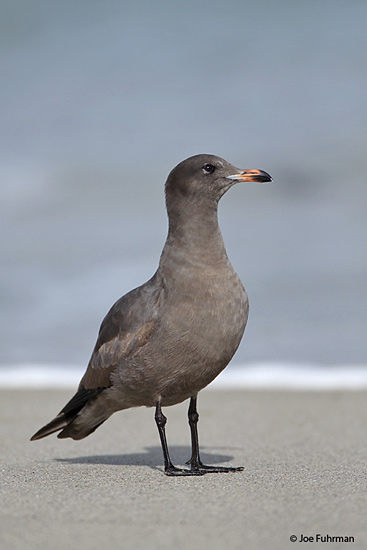tags: Heermann's Gull, Larus heermanni, birds, mystery bird, bird ID quiz
[Mystery bird] Immature (1st winter/second summer?) Heermann's Gull, Larus heermanni, photographed somewhere along the Pacific coast of the United States [I will identify this bird for you in 48 hours]
Image: Joe Fuhrman. I encourage you to purchase images from this professional photographer.
NOTE: Please name at least one field mark that supports your identification.
This species has a special natural history character that makes them especially vulnerable to extinction. Can you tell me what that is?
Heermann's Gulls nest on several small islands, including Isla Benitos, Isla Angel de la Guarda, and Isla Rasa, which supports 300,000 breeding birds. This number represents 95% of the world's breeding population of this species.
Note: Gull aficionados (I am one!) are invited to provide other interesting details about this particular bird.
- Log in to post comments


Well, nearly the entire world population of this species nests on one tiny island. That makes them pretty vulnerable, I think. These guys are great favorites of mine, so I hope nothing horrible happens to that island.
I think I got this one-black legs, almost all gray with black tipped red bill and dark eye. If my guess is right, 95% of the population nests on Isla Rasa off the coast of northwestern Mexico(according to the Audubon website.) Audubon also indicate that one of this species favorite tactics is stealing food from Brown Pelicans.
Another gorgeous image!
I love the black legs :)
Would more experienced birders think this is a non-breeding season adult, or a juvenile? I'm not seeing the white markings my book shows for adults, and it looks like the white around the eye isn't quite there. And the beak looks liss red than my book shows for adults.
It's a youngster, Bardiac. The bill's just beginning to develop some red color, and the median wing coverts seem bleached, so I'd figure maybe near the end of its first plumage cycle.
I know that on this side of the pond our terminology for moult sequences differs from yours (Vive la difference). So as this is a four-year gull (reaching maturity in 4yrs)I would say that this is a second winter bird. The red on the bill, the paler breast/belly and the grey emerging on the mantle are the field marks I would consider diagnostic.
This is actually a three-year species, Adrian, and reaches its first definitive plumage during its third autumn/winter, or at about 27-30 months of age.
Oooops! I find that I'm in error here, Adrian. Though Grant considered this bird a three-year gull, as did a number of older sources, current thinking, as expressed by Olsen & Larsson, Howell & Dunn, and Peter Pyle, considers it a four-year gull. I humbly beg forgiveness for transmitting misinformation.
That's OK Paul, I was thinking that this was la difference I referred to. The bird breeds in its 4th year and is in non-breeding plumage in its third winter. I think we agree this bird is in its 2nd winter/3rd summer, don't we?
I think I'll stick with 1st winter/2nd summer, based on those brown median coverts.